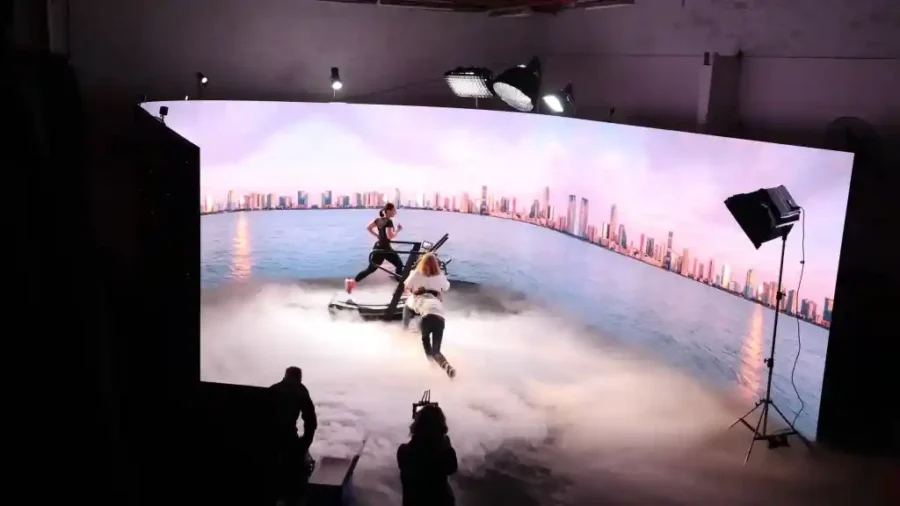The Unfolding Screen
The recent unveiling of sophisticated generative Artificial Intelligence (AI) tools, such as OpenAI’s Sora, capable of conjuring “realistic and imaginative scenes from text instructions” , and Google’s AI filmmaking tool, Flow, designed to empower storytellers in creating cinematic clips , has sent ripples across the cinematic landscape. These advancements signify more than mere software updates; they represent a potential acceleration in the democratization of media creation, potentially disrupting established industry hierarchies and the very skillsets traditionally valued in filmmaking. The public and media fascination with such technology hints at both an excitement for new creative frontiers and an underlying apprehension about the future of cinematic art, authorship, and authenticity. This moment is critical, as the dialogue between traditional filmmaking practices and emerging digital frontiers intensifies, forcing a renegotiation of how films are made, experienced, and understood in the 21st century.

Historical/Contextual Background: From Celluloid Dreams to Digital Streams
The current technological ferment in filmmaking is not an isolated phenomenon but part of a continuous evolution intrinsic to the medium since its inception. Cinema was born from technology, with the Lumière brothers’ Cinématographe and Thomas Edison’s Kinetoscope in the late 19th century demonstrating the magical ability to capture and replay motion. Early cinematic art was rapidly shaped by subsequent analog innovations. The emergence of feature-length films, such as Australia’s The Story of the Kelly Gang in 1906, allowed for more complex narratives than the initial short vignettes. The desire for greater realism and expression drove the laborious introduction of color, from Georges Méliès’ hand-colored fantasies to George Albert Smith’s Kinemacolour process in 1908, and later, the dominance of Technicolor.
The arrival of synchronized sound with “talkies” like The Jazz Singer (1927) fundamentally altered film language and performance , an innovation further explored with early multi-channel sound experiments in Disney’s Fantasia (1940). Visual effects, too, have a long lineage, with Computer Generated Imagery (CGI) making its nascent appearance in films like Westworld (1973) before becoming a ubiquitous tool.
The most profound recent shift has been the transition from analog to digital filmmaking. This revolution gained momentum with the introduction of non-linear editing software like Avid Media Composer and Adobe Premiere, offering unprecedented flexibility. Digital cinematography, championed by filmmakers like George Lucas who utilized it extensively in Star Wars: Episode II – Attack of the Clones (2002) , along with digital projection in the early 2000s, cemented this transformation. Lucas himself viewed these digital tools not as a radical break but as improvements upon existing cinematic instruments, controversially asserting that “the aesthetics are exactly the same”. This historical trajectory, from traditional celluloid to the multifaceted digital present, underscores a persistent pattern: technological advancements have consistently expanded the filmmaker’s palette, often redefining rather than merely replacing the core tenets of cinematic art. The enduring quest for greater immersion and realism has been a constant, with each new technology reshaping our understanding of what constitutes a “real” or “immersive” cinematic experience.
Key Technological Evolutions in Filmmaking
| Era/Decade | Key Technology | Key Figures/Films | Impact on Art/Aesthetics |
|---|---|---|---|
| Early Cinema (1890s-1900s) | Cinématographe, Kinetoscope, Celluloid Film | Lumière Brothers, Thomas Edison, Georges Méliès | Birth of moving images, early narrative experiments, trick films. |
| Sound (1920s-30s) | Synchronized Sound (Vitaphone, Optical Sound) | The Jazz Singer (1927) | Revolutionized narrative, performance, and genre; birth of the musical. |
| Color (1930s-50s) | Technicolor (Three-Strip Process) | The Wizard of Oz (1939), Gone with the Wind (1939) | Enhanced realism, spectacle, and emotional expression; color as a narrative tool. |
| Early CGI (1970s-80s) | Computer Generated Imagery | Westworld (1973), Tron (1982) | Introduction of digitally created visuals, new possibilities for sci-fi and fantasy. |
| Digital Revolution (1990s-2000s) | Digital Cameras, Non-Linear Editing, Digital Projection | George Lucas (Star Wars Prequels), Avid, Adobe Premiere | Increased flexibility, accessibility, new VFX capabilities, shift in distribution. |
Current Landscape: The Converging Realities of Modern Moviemaking
The contemporary filmmaking ecosystem is characterized by a pervasive and increasingly sophisticated array of digital tools that are not merely supplementing traditional methods but are actively merging with them to forge new, hybrid workflows. At the forefront of this transformation is Artificial Intelligence (AI). Generative AI models like OpenAI’s Sora and Google’s Flow are demonstrating remarkable capabilities in video generation from text prompts, with projects like Ancestra, from Darren Aronofsky’s Primordial Soup venture, utilizing Google AI tools for its debut at the 2025 Tribeca Film Festival. Beyond generation, AI is being integrated into pre-production for scriptwriting assistance and storyboarding , into production for tasks like de-aging actors , and extensively into post-production through AI-driven editing tools. As VFX supervisor Joe Letteri noted, AI tools are unlikely to replace artists but will “expand the creative scope of what we imagine”. Key corporate players in this space include OpenAI, Google, NVIDIA with its Omniverse platform, and Adobe with its Sensei AI. New entities like Staircase Studios AI are even emerging with ambitions to produce entire slates of AI-generated films.
Virtual Production (VP) represents another significant shift, employing LED walls (often called “volumes”), real-time rendering engines like Epic Games’ Unreal Engine, and motion capture to create dynamic, photorealistic digital environments directly on set. This technology allows filmmakers to see and interact with virtual worlds in real-time, revolutionizing set design, minimizing the need for extensive location shooting, and offering greater in-camera creative control. Disney+’s The Mandalorian famously popularized this approach , and cinematographers like Curtis Clark, ASC, have lauded VP for enabling their participation in the on-set creation of CG characters.
Immersive technologies such as Virtual Reality (VR) and Augmented Reality (AR) are also carving out new territories in cinematic storytelling. VR filmmaking, in particular, is “reshaping the industry” by offering experiences where viewers can “step inside stories”. Works like Alejandro González Iñárritu’s Carne y Arena , along with a growing body of VR documentaries and experimental pieces showcased at festivals like Venice Immersive and Sundance New Frontier , demonstrate the evolving language of immersive narrative. Tech giants like Meta and HTC Vive are prominent in developing the hardware and platforms for these experiences.
The distribution landscape continues to be dominated by streaming platforms. Netflix and Disney+ collectively invested a staggering $16.3 billion in original content in 2022 , and the global movies and entertainment market is projected for robust growth, reaching $152.09 billion by 2029, largely fueled by streaming. For independent filmmakers, these platforms offer unprecedented global reach and new funding avenues , though this comes with the challenges of an “overcrowded marketplace” and the influence of algorithmic content curation. The industry is also navigating the aftermath of the 2023 WGA, DGA, and SAG-AFTRA strikes, which caused a significant downturn in production volume; Hollywood studio spending, for example, dropped by 20% in the second quarter of 2024 compared to the same period in 2022. This contraction in studio output, however, may paradoxically spur an increase in independent film production, often supported by various production incentives.
This confluence of technologies is leading to a blurring of traditional production phases. Creative decisions are increasingly front-loaded or made iteratively, with tools like virtual production allowing for previsualization, set design, and even final pixel work to occur more fluidly and concurrently. Furthermore, a complex dynamic is emerging: while some technologies appear to democratize filmmaking by lowering barriers to entry for independent creators , the high cost of other cutting-edge systems (like large LED volumes ) and the control of advanced AI models and data by major tech corporations and streaming platforms risk consolidating power. Underlying these shifts is the increasing importance of data, its acquisition, control, and ethical deployment, which is becoming a critical resource in training AI, tailoring content, and managing vast digital asset libraries, raising profound questions about intellectual property and privacy.

Critical Perspectives: The Art in the Algorithm and the Ghost in the Machine
The rapid integration of new technologies into filmmaking has ignited a range of critical debates concerning aesthetics, authorship, and ethics. A distinct “AI aesthetic” is emerging, often characterized by “blurry, morphing, and surreal” visuals. While some artists embrace these qualities as a new visual language , others, including film students, perceive AI-generated visuals as “inauthentic, overly polished, or hegemonic” , questioning whether AI can produce genuine art. This intersects with discussions around virtual production, which offers “limitless creative possibilities” but can sometimes sacrifice the perceived authenticity of traditional cinematography, such as natural lighting or the tangible interaction of actors with physical sets. There’s an ongoing debate about whether these digital tools lead to a homogenization of style, a concern amplified by AI models trained on existing data, which might “lead to a homogenization of creative output, potentially undermining originality and diversity,” as noted by Zhu & Zhang (2022). Streaming platform algorithms, often favoring content that aligns with past successes, can also contribute to this trend.
The very notion of authorship is being challenged. The traditional auteur theory, which posits the director as the singular visionary, is complicated when AI can generate scripts, edit sequences, or even create entire visual styles. The director’s role may evolve into that of a “curator” or an “orchestrator of human-machine symbiosis”. Lev Manovich’s work suggests that AI outputs, while often stereotypical if unguided, are not mere replicas but can be genuinely new cultural artifacts. Recognizing this evolving landscape, the Academy of Motion Picture Arts and Sciences has introduced rules requiring “significant human creative control” for Oscar eligibility in key categories and mandating disclosure of AI use.
Profound ethical and cultural dilemmas accompany these technological shifts. The 2023 Hollywood strikes highlighted deep concerns among film workers regarding AI’s potential impact on wages, job security, and the devaluation of human craft. Copyright and intellectual property are central battlegrounds, particularly the use of copyrighted materials for training AI models without consent or compensation, and the unresolved question of who owns AI-generated content. The proliferation of sophisticated deepfake technology also raises alarms about misinformation, non-consensual use, and the erosion of trust in visual media , while the “uncanny valley” remains a persistent challenge for hyperrealistic AI-generated characters. Furthermore, AI systems can inherit and amplify biases present in their training data, affecting on-screen representation. While digital tools have the potential to democratize filmmaking , concerns remain about whether new technologies will genuinely foster more diverse narratives or if market pressures and algorithmic bias will curtail this potential. The 2023 UCLA Hollywood Diversity Report indicated that streaming films offered better representation for women and people of color than theatrical releases, yet budget and employment disparities persist.
The prevailing discourse attempts to frame AI as a “tool” to assist human creativity, a narrative evident in industry statements and institutional guidelines. However, the increasing sophistication of generative AI continuously blurs this distinction. This “tool” framing may be both a strategic effort to maintain human agency and a response to the inherent challenge posed by technologies that can autonomously generate creative content. As AI makes content generation prolific, the human skills of critical judgment, aesthetic curation, and the ability to imbue work with a unique vision become paramount, potentially redefining artistic “craft” in the digital age. While the speed of AI development often outpaces the establishment of comprehensive legal and ethical frameworks, there is a notable proactive effort from industry bodies and academia to address these complex issues, suggesting a collective attempt to shape, rather than merely react to, AI’s integration into the cinematic art form.

Speculative or Forward-Looking Analysis: Projecting the Next Reel
Emerging trends suggest a future where filmmaking becomes increasingly interactive, personalized, and immersive. The market for AI-generated interactive movies, where audiences can influence plotlines, is projected to reach $31.1 billion by 2034. This aligns with the potential of VR and AR to create participatory storytelling experiences , possibly culminating in “metaverse cinema”–shared, interactive VR environments where audiences can “enter” films and interact with AI-driven characters. AI’s analytical capabilities could also lead to hyper-personalized content, micro-targeting niche audience segments with tailored narratives.
Over the next five to ten years, sophisticated AI tools like Sora and Flow are likely to see wider adoption across various production scales. Virtual production techniques, currently prominent in blockbusters, are expected to become more refined and potentially more accessible. Distribution models will continue to evolve beyond current streaming dominance, with explorations into blockchain for film financing and IP management gaining traction. Early signals of these shifts include the Academy’s new AI rules , dedicated funding for AI-driven film projects like Runway ML’s Hundred Film Fund , and the increasing presence of AI and VR/XR works at major film festivals. Lev Manovich’s framing of “AI media” as a contemporary form of “database art” suggests a future where AI is integrated as a novel method for interpreting and creating from vast cultural archives.
The trajectory of filmmaking is not a wholesale replacement of the traditional by the digital or the AI-driven, but rather an increasingly complex hybridization of techniques and philosophies. Virtual production inherently blends physical and digital realities , and AI is being woven into existing workflows rather than supplanting them entirely. This points towards a future where filmmakers will draw from an expanded palette, selecting tools based on artistic intent and resources, fostering a diverse technological and aesthetic landscape. Furthermore, the emphasis on interactive narratives and immersive experiences suggests a broader shift towards an “experience economy” in cinema, where the value of a film may increasingly be tied to the uniqueness and engagement level of the individual experience. This evolving landscape will demand continuous adaptation from creators, critics, and audiences alike, as ethical guidelines, creative practices, and media literacy will need to constantly adjust to the pace of technology.
The Enduring Narrative
The provocative emergence of tools like Sora and Flow , capable of generating cinematic visuals from mere text, underscores a pivotal moment in filmmaking. Yet, amidst the dazzling potential of such technology, the fundamental human impulse for storytelling endures. The future of filmmaking is not a singular, technologically determined path but a dynamic confluence where traditional craftsmanship will inevitably coexist, challenge, and merge with digital and AI-driven innovation. The essential challenge, and indeed, the profound opportunity, lies in harnessing these potent new instruments to expand creative expression, democratize access to the medium, and forge novel cinematic languages. This pursuit must be balanced with a rigorous engagement with the attendant ethical considerations, ensuring that the human heart of cinematic art is not just preserved but amplified. The screen, in all its evolving forms, will continue to unfold, prompting ongoing discourse rather than definitive answers, as the narrative of filmmaking itself is perpetually rewritten, frame by digital frame, algorithm by human insight.









